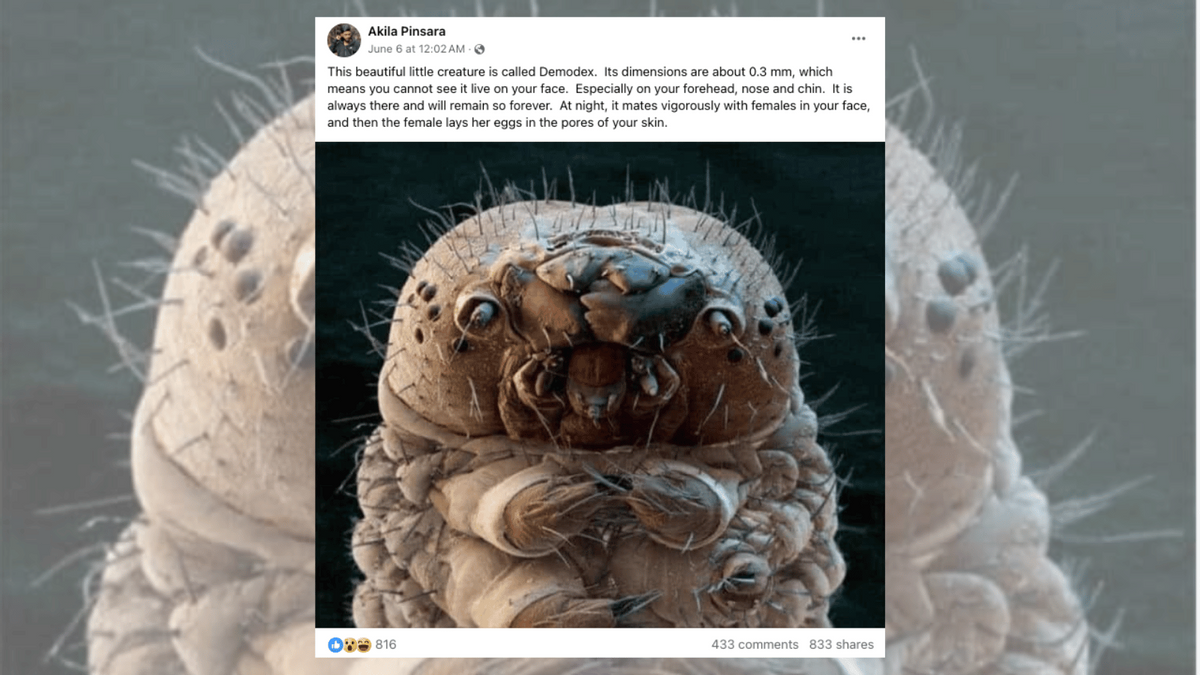Fact Check: About That Alleged Pic of Demodex Mites That Live on Human Faces

Claim:
A viral image authentically shows a Demodex mite that lives on human faces.
Rating:
Context:
While the scanning electron micrograph is genuine and unaltered, it shows the head of a silkworm moth caterpillar and not a Demodex mite, as posts on social media misleadingly claimed.
In June 2024, posts in multiple Facebook groups claimed to show an image of a microscopic creature identified as a Demodex mite, a tiny arthropod that lives, mates, and lays eggs on human facial skin.
The wording of the nearly identical posts first appeared in a post made in a Neil deGrasse Tyson fan group on May 30, 2023. As of this writing, that original post had received around 1,500 comments and around 2,900 shares. The image accompanied by the same caption has also appeared on other social media sites including X, Instagram, and LinkedIn.

(X user @fopminui)
But the viral posts were incorrect. Reverse-image searches on TinEye and Google Images led us to the stock image agency Alamy, which licenses the original image and identifies it as a colored scanning electron micrograph of the head of a silkworm moth caterpillar.
To verify this identification, Snopes reached out to entomologists Kyle Koch, an educator and diagnostician at the University of Nebraska–Lincoln, and Lynn Kimsey, an emeritus professor of entomology at the University of California, Davis. Both Koch and Kimsey confirmed via email that the creature in the image is a caterpillar and not a Demodex mite.
For these reasons, we have rated the claim as "Miscaptioned," meaning that it is a genuine, unaltered image that has been accompanied by a misleading caption.
Although the viral image does not depict one, the Demodex genus of mites are very real. Two species in the genus, Demodex folliculorum and Demodex brevis, do live on human faces and are collectively referred to as facial mites. According to a paper published in the scientific journal Dermatology Reports in 2022, mites of both species are common human parasites that, according to some studies, have been found on the skin of up to 100% of adults and 70% of children.
To the untrained eye, the lumpy bodies and stubby legs of Demodex mites, which are arthropods, and silkworm moth caterpillars, which are insects, share some similarities. The most glaring difference between the animals is their size: while adult Demodex mites reach a maximum length of around 0.4 millimeters, silkworm moth caterpillars measure around 2 millimeters just after hatching and grow to a maximum length of around 75 millimeters before they build cocoons and begin the process of pupation into an adult silkworm moth, according to the Encyclopedia Britannica.
This difference in scale, however, is not immediately obvious when dealing with a close-up image like the one in question.
For entomologists like Koch, other features of the specimen that appears in the viral image make it easy to determine that the animal is not a mite from the Demodex genus even when size cannot be taken into account.
One feature that stood out to Koch was the morphology of the specimen's mouth, which he explained does not resemble the needle-like chelicerae or beak-like rostrum found across the many Demodex species. Another clue was the hairlike bristles visible all over the creature in the viral images. Known to entomologists as setae, these bristles are never found on Demodex mites, which are instead covered in tiny, semi-transparent scales.
A real Demodex mite can be seen crawling up a human eyelash in the video below, which the biotechnology company BioTissue posted to YouTube in 2014.
Information from reverse-image searches shows that the image from the viral posts has circulated on social media sites since at least 2014, when a Reddit user posted it to the r/WTF subreddit. Notably, this 2014 post correctly identified the creature as a silkworm.
The Demodex misidentification appears to have emerged in June 2018, when X user @AntonioParis posted the image with a caption reading, "An alien from another world? This is a microscopic image of Demodex. These mites live on your face." Similar posts sharing the misidentified image soon appeared in posts on Reddit, Facebook, and other social media sites, and have periodically circulated ever since.
Sources:
Evon, Dan. "Snopes Tips: A Guide To Performing Reverse Image Searches." Snopes, 22 Mar. 2022, https://www.snopes.com//articles/400681/how-to-perform-reverse-image-searches/.
Paichitrojjana, Anon. "Demodex: The Worst Enemies Are the Ones That Used to Be Friends." Dermatology Reports, vol. 14, no. 3, Mar. 2022, p. 9339. PubMed Central, https://doi.org/10.4081/dr.2022.9339.
Silkworm. Coloured Scanning Electron Micrograph (SEM) of the Head of a Silkworm Moth Caterpillar (Bombyx Mori). The Silkworm Uses Its Chewing Mouthpar Stock Photo - Alamy. https://www.alamy.com/silkworm-coloured-scanning-electron-micrograph-sem-of-the-head-of-a-silkworm-moth-caterpillar-bombyx-mori-the-silkworm-uses-its-chewing-mouthpar-image335469334.html. Accessed 12 June 2024.
Silkworm Moth | Lepidoptera, Bombyx Mori, Cocooning | Britannica. 26 Apr. 2024, https://www.britannica.com/animal/silkworm-moth.

 Yahoo News
Yahoo News 

